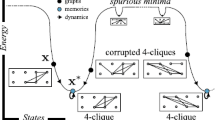Abstract
We apply evolutionary computations to the Hopfield’s neural network model of associative memory. In the model, a number of patterns can be stored in the network as attractors if synaptic weights are determined appropriately. So far, we have explored weight space to search for the optimal weight configuration that creates attractors at the location of patterns to be stored. In this paper, on the other hand, we explore pattern space to search for attractors that are created by a fixed weight configuration. All the solutions in this case are a priori known. The purpose of this paper is to study the ability of a niching genetic algorithm to locate these multiple solutions using the Hopfield model as a test function.
Access this chapter
Tax calculation will be finalised at checkout
Purchases are for personal use only
Preview
Unable to display preview. Download preview PDF.
Similar content being viewed by others
References
Amit, D. J. (1989) Modeling Brain Function: The World of Attractor Neural Networks. Cambridge University Press.
Davis, L (1991) Bit-Climbing, Representation Bias, and Test Suite Design. Proceedings of the 4th International Conference on Genetic Algorithms, pp.18–23.
De Jong, K. A. (1975) An Analysis of the Behavior of a Class of Genetic Adaptive Systems. Ph.D. theses University of Michigan.
Gardner, E. (1988) The Phase Space of Interactions in Neural Network Models. Journal of Physics, 21A, pp257–270.
Goldberg, D. E., and J. Richardson (1987) Genetic Algorithms with Sharing for Multimodal function Optimization. Proceedings of 2nd International Conference on Genetic Algorithms, pp.41–49.
Hebb, D. O. (1949) The Organization of Behavior. Wiley.
Holland, J. (1975) Adaptation in Natural and Artificial Systems. The University of Michigan Press.
Hopfield, J. J. (1982) Neural Networks and Physical Systems with Emergent Collective Computational Abilities. Proceedings of the National Academy of Sciences, USA, 79, pp2554–2558.
Imada, A., and K. Araki (1997a), Random Perturbations to Hebbian Synapses of Associative Memory using a Genetic Algorithm. Proceedings of International Work-Conference on Artificial and Natural Neural Networks. Springer Verlag, Lecture Notes in Computer Science, No.1240, pp398–407.
Imada, A., and K. Araki (1997b) Evolution of Hopfield Model of Associative Memory by the Breeder Genetic Algorithm. Proceedings of the 7th International Conference on Genetic Algorithms, pp784–791.
Komlós, J., and R. Paturi (1988) Convergence Results in an Associative Memory Model. Neural Networks 1, pp239–250.
Mahfoud, S. W. (1992) A Comparison of Parallel and Sequential Niching Methods. Proceedings of the 2nd Parallel Problem Solving from Nature, pp.27–36.
Mahfoud, S. W. (1995) A Comparison of Parallel and Sequential Niching Methods. Proceedings of the 6th International Conference on Genetic Algorithms, pp.136–143.
Mattis, D. C. (1976) Solvable Spin Systems with Random Interactions. Physics Letters, 56A, pp421–422.
Sherrington, D., and S. Kirkpatrick (1975) Solvable Model of a Spin Glass. Physical Review Letters 35, pp1792–1796.
Syswerda, G. (1989) Uniform Crossover in Genetic Algorithms. Proceedings of the 3rd International Conference on Genetic Algorithms, pp2–9.
Whitley, D., K. Mathias, S. Rana, and J. Dzubera (1995) Building Better Test Functions. Proceedings of the 6th International Conference on Genetic Algorithms, pp239–246.
Author information
Authors and Affiliations
Editor information
Editors and Affiliations
Rights and permissions
Copyright information
© 1999 Springer-Verlag Berlin Heidelberg
About this paper
Cite this paper
Imada, A., Araki, K. (1999). Can a Niching Method Locate Multiple Attractors Embedded in the Hopfield Network?. In: McKay, B., Yao, X., Newton, C.S., Kim, JH., Furuhashi, T. (eds) Simulated Evolution and Learning. SEAL 1998. Lecture Notes in Computer Science(), vol 1585. Springer, Berlin, Heidelberg. https://doi.org/10.1007/3-540-48873-1_42
Download citation
DOI: https://doi.org/10.1007/3-540-48873-1_42
Published:
Publisher Name: Springer, Berlin, Heidelberg
Print ISBN: 978-3-540-65907-5
Online ISBN: 978-3-540-48873-6
eBook Packages: Springer Book Archive




